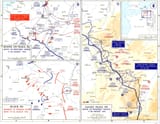Search Results
6/11/2025, 6:06:57 AM
>>63807025
You have to look at the French Plan XVII. They attempted to follow this plan at the start of the war. While the Schlieffen plan was a broad hook through the low countries and into France, XVII was done under the assumption that the Germans would launch their primary offensive from the Alsace-Lorraine area due to the logistics already in place.
It thus called for a counter offensive into there. If they were correct on where the Germans were moving from, and the timing was right, it would have been fairly effective.
Think of the Battle of Waterloo when the huge French infantry column is marching towards Wellington's left. The Scots Greys completely blunted and slaughtered that offensive (even if they over committed).
While not taken to literally imply the cavalry would have charged the Germans as a primary action, XVII was an attempt to let the Germans move first and then hit them mid-action with a counter thrust.
In the early days of the war, there was a considerable French force amassing along the Lorraine ridge. I know General Levillain was in command of the 6th Cavalry Division.
The Cavalry, all forms, was to act as scouts and screening. Heavy cavalry would be akin to how US tank doctrine kept the TDs in reserve until needed and then deployed as a rapid heavy punch.
People forget that the Germans also deployed cavalry as screening and scouting in these days as well.
Well, it turns out that there in Lorraine, the cavalry on both sides kind of sucked at screening movement and scouting for the enemy. However, because the Germans had the operational tempo and resolve, AND that their cavalry was much more integrated with light infantry and attached light artillery/machine gun vs French cavalry operating as its own force, when clashes DID happen, German forces were more quickly able to respond and seize initiative.
You have to look at the French Plan XVII. They attempted to follow this plan at the start of the war. While the Schlieffen plan was a broad hook through the low countries and into France, XVII was done under the assumption that the Germans would launch their primary offensive from the Alsace-Lorraine area due to the logistics already in place.
It thus called for a counter offensive into there. If they were correct on where the Germans were moving from, and the timing was right, it would have been fairly effective.
Think of the Battle of Waterloo when the huge French infantry column is marching towards Wellington's left. The Scots Greys completely blunted and slaughtered that offensive (even if they over committed).
While not taken to literally imply the cavalry would have charged the Germans as a primary action, XVII was an attempt to let the Germans move first and then hit them mid-action with a counter thrust.
In the early days of the war, there was a considerable French force amassing along the Lorraine ridge. I know General Levillain was in command of the 6th Cavalry Division.
The Cavalry, all forms, was to act as scouts and screening. Heavy cavalry would be akin to how US tank doctrine kept the TDs in reserve until needed and then deployed as a rapid heavy punch.
People forget that the Germans also deployed cavalry as screening and scouting in these days as well.
Well, it turns out that there in Lorraine, the cavalry on both sides kind of sucked at screening movement and scouting for the enemy. However, because the Germans had the operational tempo and resolve, AND that their cavalry was much more integrated with light infantry and attached light artillery/machine gun vs French cavalry operating as its own force, when clashes DID happen, German forces were more quickly able to respond and seize initiative.
Page 1
